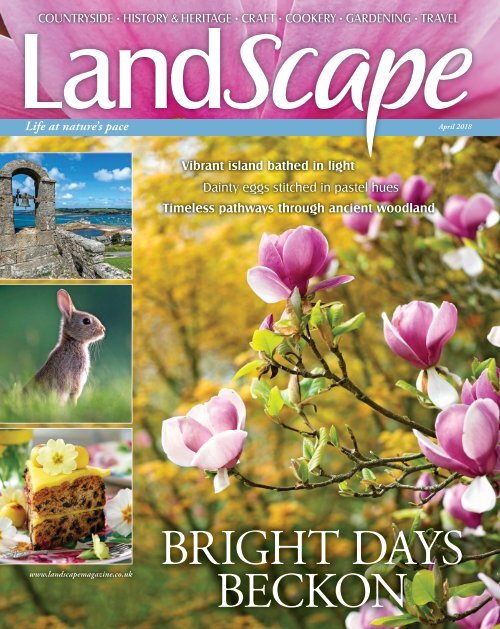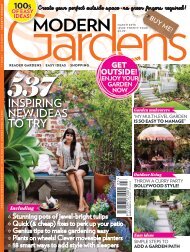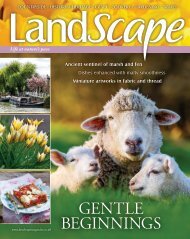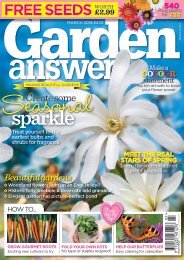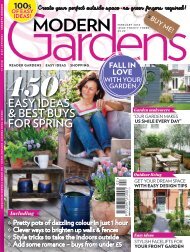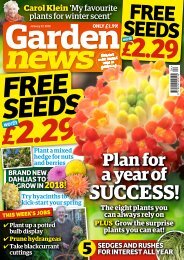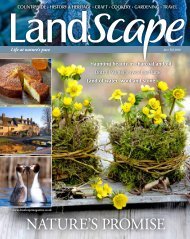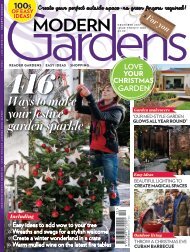Create successful ePaper yourself
Turn your PDF publications into a flip-book with our unique Google optimized e-Paper software.
COUNTRYSIDE ▯ HISTORY & HERITAGE ▯ CRAFT ▯ COOKERY ▯ GARDENING ▯ TRAVEL<br />
Life at nature’s pace<br />
<strong>April</strong> 2018<br />
Vibrant island bathed in light<br />
Dainty eggs stitched in pastel hues<br />
Timeless pathways through ancient woodland<br />
www.landscapemagazine.co.uk<br />
1<br />
BRIGHT DAYS<br />
BECKON
Contents<br />
<strong>April</strong> 2018<br />
67<br />
90<br />
30<br />
In the garden<br />
In the kitchen<br />
Craft<br />
10 Haven of water-loving plants<br />
20 Fanning ferns reveal their beauty<br />
30 Kerria japonica’s burst of sunshine<br />
36 The garden in <strong>April</strong><br />
46 Delicately sweet petal toppings<br />
54 Tasty twist on breakfast dishes<br />
62 Sumptuous fruity bake<br />
64 Regional & Seasonal:<br />
Hocking’s Dairy Cream Ices<br />
41 From pallet to bike rack<br />
67 Gloves turn into friendly bunnies<br />
70 Flowers of intricate threads<br />
78 Pretty pastel felt eggs<br />
4
112<br />
46<br />
41<br />
Country matters<br />
70<br />
History and heritage<br />
Regulars<br />
82 Creatures brought to life in wire<br />
90 Underground world of the rabbit<br />
96 Seeds equipped for survival<br />
102 The countryside in <strong>April</strong><br />
104 Wood shaped in timeless tradition<br />
112 Colourful island of azure bays<br />
6 Readers’ letters<br />
8 Our <strong>LandScape</strong><br />
28 In the garden<br />
44 In the kitchen<br />
52 Subscription offer<br />
80 In the home<br />
122 UK events<br />
5
spring’s soft hues<br />
Tactile padded eggs, sewn from felt and adorned with flowers in<br />
delicate colours, add a seasonal decoration to the home<br />
78
Pure white felt eggs, sprinkled with decorative flowers, are delicately<br />
pretty and irresistible to touch. Looped over a spring branch, they create an<br />
attractive indoor feature and are easy to make. Using material with high wool<br />
content ensures the eggs better hold their shape. Felt in complementary<br />
colours or leftover scraps of fabric can be used for the flowers and leaves. The<br />
templates below are firstly photocopied or traced, neatly cut out and pinned to a<br />
square of felt. The pieces are then carefully cut out with a pair of sharp fabric<br />
scissors. Each hanging decoration requires two matching egg shapes, one narrow 4in<br />
(10cm) strip of fabric and as many floral trimmings as desired. It is easiest to stitch<br />
the flowers and leaves in place before sewing the two egg halves together. Small<br />
beads or buttons can be added for embellishment. The fabric strip is folded in half<br />
and both ends sandwiched between the two egg shapes. The eggs are then sewn<br />
together, starting from the top and leaving a 1in (2.5cm) gap. They are stuffed with<br />
a pinch of small fabric scraps before the final stitches close the egg.<br />
materials<br />
• Felt in white and pastel shades<br />
• Sewing thread in matching colours<br />
• Small fabric scraps for the stuffing<br />
• Seed beads<br />
• Small buttons<br />
• Fabric scissors<br />
• Hand sewing needle<br />
▯ Photography: Richard Faulks<br />
79
from<br />
curls<br />
to fans<br />
Luxuriant ferns bring a fresh<br />
green canopy to the garden as<br />
they slowly unwind<br />
agently unfurling fern frond<br />
slowly performs one of nature’s miracles of<br />
transformation. Gradually, it turns from a<br />
hairy stem, shaped like a shepherd’s crook, to<br />
a majestic, feathered wand of foliage. Amid the<br />
brightly coloured show of spring-flowering bulbs, the<br />
intricacy of a developing fern is complex and<br />
captivating. The coiled young fern fronds, known as<br />
crosiers, demand to be seen every day as they gradually<br />
uncurl into a myriad of shapes.<br />
Many hardy ferns are suitable for growing in<br />
British gardens. Whether evergreen or deciduous,<br />
low-growing or planted for height and stature, they<br />
bring an ethereal beauty. Some grow best in the sun;<br />
others prefer cool, shady spots. They are not restricted<br />
to the ground. Some, known as epiphytic ferns,<br />
are capable of growing in the crevices of trees and<br />
rocks. They have one thing in common: once unfurled,<br />
they provide an abundance of decorative greenery. ›<br />
Shaped like the scroll of a violin, a young<br />
fern uncoils in response to the light.<br />
20
Athyrium ‘Ghost’ reveals<br />
its lush foliage on purplish<br />
stems. Each blade, the<br />
leafy part of the frond, is<br />
divided into tapering pinnae<br />
made up of smaller leaflets<br />
called pinnules.
In the garden<br />
Seasonal ideas for your outdoor space<br />
dash of blue<br />
Flitting high around trees and vegetation on gentle spring days, the Holly Blue is one of<br />
the first butterflies of the year to emerge. In the early days of the season, as its name<br />
suggests, it can be found concentrated around holly bushes, which provide nourishment<br />
for the caterpillars of the season’s generation. The Holly Blue, Celastrina argiolus, can<br />
be reliably identified by the pale silvery blue underside of its wings, with small black<br />
dots, but never any orange as in other blue species. The upper wing is a bright blue,<br />
edged with black, with a broader dark edge on females. It is a common sight in gardens<br />
throughout England and Wales, particularly in the south, flying much higher than other<br />
blue species, which tend to stay closer to the ground. The flash of its bright wings are a<br />
welcome sign that days are warming and growing lighter.<br />
sowing wild<br />
flowers<br />
Native wild flowers will provide colour and pollen for<br />
bees throughout the summer. As long as the ground<br />
is well prepared, they are easy to start off and<br />
maintain. The soil is dug over and any plants or roots<br />
diligently removed. No fertiliser is required as grasses<br />
thrive in nutrient-rich soil and can outcompete any<br />
flowers. The soil is then raked to a crumbly<br />
consistency and the seeds scattered over evenly by<br />
hand. Including some sand in the mix can help make<br />
it easier to see where they fall. Many seeds need<br />
sunlight to germinate so are not buried, but can be<br />
gently raked over to provide some protection and<br />
prevent them blowing away. The area is then watered<br />
and left alone, except in dry spells when more<br />
watering may be necessary. In summer, the blooms<br />
will create a vibrant, colourful patch.<br />
helping hedgehogs<br />
When Jo Sara began designing mosaic items for the garden, she wanted her<br />
creations to be both beautiful and helpful to wildlife. This pretty water dish<br />
for hedgehogs is heavy enough not to tip up as they drink. It measures<br />
21cm in diameter and is 4.5cm tall, giving a water depth of 3cm. The dish is<br />
made of frost-resistant materials which repel mould and algae.<br />
Rainbow hedgehog mosaic water dish £33, www.josara.co.uk<br />
28
heart<br />
of the<br />
season<br />
The pink pendant flowers of bleeding heart<br />
are suspended from a slender arching stem,<br />
elegantly lined up side-by-side. This is an<br />
early-flowering perennial, first appearing in<br />
gardens in <strong>April</strong> and continuing until June. Its<br />
heart-shaped flowers are a rich fuchsia pink<br />
at the base, rounding to a creamy, paler pink<br />
at the top, with mainly white inner petals<br />
hanging below. These pretty flowers sprout<br />
from a hardy plant which can withstand<br />
temperatures as low as -20°C. Bleeding<br />
heart, Lamprocapnos spectabilis, does well<br />
in either bright sunlight or dappled shade<br />
and rich fertile soil. This should be well<br />
watered to ensure the ground is kept moist.<br />
With the same care, it can also be grown in<br />
containers. These bright and unusual flowers<br />
make a striking sight in a border when mixed<br />
with other later flowering plants to retain<br />
interest as the year progresses.<br />
Photography: Richard Faulks; Florapress; Alamy<br />
foraging in the grass<br />
A pair of chickens search for seed in the grass, their movements<br />
captured in rusted metal. Cut from steel sheets, they have been<br />
rusted by hand to a unique finish. Steve and Sara Raven started<br />
their business creating unique animals and sculptures after retiring<br />
from farming, having been inspired by their work and the<br />
surrounding Fenland countryside. Once installed, the hens require no<br />
care and can be observed and enjoyed all year round.<br />
Rusty metal hen £16 each,<br />
www.rustyrooster.co.uk<br />
goodness from weeds<br />
Dandelions have a long taproot which absorbs many minerals from the<br />
ground, particularly potassium and magnesium. Though often unwelcome<br />
in the garden, they can be used in a rich, simple fertiliser. After lifting, the<br />
flower, leaves and root are stored in a bucket. The plants are packed tightly<br />
and when the bucket is two thirds full, are weighed down with a brick or<br />
rock. The bucket is then topped up with rainwater and covered with a<br />
loose-fitting lid or mesh to keep out flies and capture the pungent smell.<br />
The mixture will ferment, creating carbon dioxide, so an airtight lid is not<br />
recommended. It is then left for a minimum of three days and a maximum<br />
of two weeks. Before using, it should be strained to remove any seeds and<br />
diluted to one tenth of its strength. Other weeds, such as nettles and<br />
horsetail, can also be included.
slotted in place<br />
A wooden pallet is transformed into a rack perfect for keeping bicycles<br />
neatly and securely stored between outings<br />
41
A<br />
wooden pallet can be given new life<br />
as a bicycle rack in a simple project for a fine<br />
spring afternoon. It provides a sturdy and<br />
practical means of keeping bicycles upright and<br />
tidy in readiness for enjoying days out on two wheels<br />
during glorious spring days.<br />
Once completed, the rack can be painted or<br />
weatherproofed to protect the wood from the elements.<br />
The top provides a shelf on which to stand pretty plant<br />
containers to add a decorative splash of colour.<br />
materials<br />
• Pallet with slats approximately<br />
2-4in (5-10cm) apart, to<br />
comfortably fit the wheel width<br />
• Pencil<br />
• Ruler<br />
• Handsaw<br />
• Electric drill<br />
• Screwdriver<br />
• 2in (5cm) screws<br />
• Timber treatment or exterior<br />
paint (optional)<br />
constructing the rack<br />
1.<br />
Step 1: Using a ruler,<br />
a line is marked in<br />
pencil across all the<br />
slats of the pallet to<br />
one side of the middle<br />
strengthening bar. The<br />
pallet is carefully cut in<br />
two along this line, using<br />
a handsaw, resulting in<br />
two pieces of slightly<br />
different sizes.<br />
2.<br />
Step 2: The larger<br />
section is laid down and<br />
the smaller piece placed<br />
upright on top with the cut<br />
ends butting up to it. The<br />
seven front slats of the<br />
upright piece should sit in<br />
front of the block on the<br />
back of the base pallet.<br />
Three lines are then drawn<br />
in pencil along the edges<br />
of the upright pallet ends<br />
to mark their position.<br />
42
An ARTFUL<br />
resident<br />
As the rising sun breathes life into a new<br />
morning, below ground a warren of fleetfooted<br />
rabbits are beginning to stir<br />
Dawn breaks on a sunny day in<br />
mid spring over a bank pockmarked<br />
with deep holes. In the bushes, the birds<br />
start to sing, but all is quiet on the<br />
ground. A single rabbit pokes its nose out of one of<br />
the holes and sniffs the air, as if testing whether it<br />
is safe to emerge. A few seconds later, he lifts up<br />
his head and looks around, checking that there are<br />
no predators nearby. Once he is sure all is well, he<br />
propels himself out of the warren with powerful<br />
hind legs and begins to feed.<br />
This is the signal for other rabbits to emerge,<br />
and soon the whole area around the warren is alive<br />
with activity. Some stand almost upright, their<br />
ears pricked and noses twitching, alert for any<br />
danger. Others feed, nibbling the short grass with<br />
their long front teeth. After a while, some begin to<br />
play, romping around like carefree children.<br />
This is a scene that has been re-enacted across<br />
the British countryside for 2,000 years.<br />
Introduced first by the Romans, then<br />
re-introduced by the Normans for food and fur,<br />
the European rabbit (Oryctolagus cuniculus) has<br />
shaped the landscape and ecosystems extensively. ›<br />
Alert and still, a wild rabbit<br />
harnesses its senses to detect the<br />
presence of predators. When danger<br />
is perceived, the tendency is to<br />
freeze and hide under cover.<br />
90
91
54
A twist on<br />
tradition<br />
The long-established British breakfast staples of bacon and eggs are<br />
used in a variety of mouth-watering savoury dishes to begin the day<br />
The smoky scent of bacon drifts through the<br />
morning air. In the kitchen, thick, pink rashers sizzle<br />
on the stove. With a brisk crack, a fresh egg is broken<br />
alongside, frying quickly to a creamy white, with a<br />
deep, orangey yolk in its centre.<br />
Bacon and eggs are a firmly established British breakfast; a<br />
quick and filling meal with which to start the day. But it has<br />
not always been the case, and it was only after the Industrial<br />
Revolution that the meal became a regular part of the diet.<br />
Before then, in the Middle Ages, a lavish breakfast had<br />
been the preserve of the gentry and landed classes, and usually<br />
accompanied an important event, such as a wedding. This was<br />
also a chance to display wealth, and the table bore an<br />
abundance of produce from the host’s estate. In contrast, a<br />
working class breakfast consisted of bread and ale, sometimes<br />
served with cold meat or dripping.<br />
A wealthy middle class began to emerge in the Victorian<br />
era, who sought to replicate the traditions of the privileged,<br />
including that of a sumptuous breakfast. The Industrial<br />
Revolution also marked a shift in working culture as more<br />
people began to work from 9am until 5pm. A hearty breakfast<br />
would fill the stomach for the full day ahead, and the breakfast<br />
table became a place the family could gather before each<br />
member was drawn off to work or school. Bacon and eggs soon<br />
became a staple of the worker’s diet.<br />
Preparation and cooking<br />
Back bacon is the most popular cut in the UK and includes the<br />
loin from the back of the pig, which is lean, and the belly,<br />
which is more fatty. It is traditionally cured in a brine or<br />
dry-cured with a salt rub, which may also include sugar and<br />
spices. Smoking afterwards is optional. Streaky bacon includes<br />
more belly and has layers of fat parallel to the rind.<br />
When buying bacon, a deep pink meat is chosen with no<br />
yellow or green sheen. The fat should be white, if unsmoked,<br />
and the meat firm and moist, rather than wet or slimy.<br />
Bacon is usually either fried in its own fat or grilled.<br />
Cooking it using a griddle pan can create darker stripes.<br />
Egg quality is often affected by the diet and well-being of<br />
the chicken. Unblemished eggs, devoid of cracks, are best, and<br />
a plump, round yolk indicates freshness.<br />
Eggshells are slightly porous and can take on other smells<br />
and flavours, so are best kept in the carton. They should be<br />
stored in a dark place, below 20°C, where the temperature<br />
does not fluctuate much. The main body of the fridge is<br />
reliable, but eggs should be allowed to reach room<br />
temperature before cooking. If too cold, there is a tendency<br />
for the yolk to overcook while allowing the white to set.<br />
For an egg-and-bacon breakfast, they are usually fried, for<br />
which the remaining bacon fat can be used. The egg is broken<br />
into a non-stick frying pan as soon as the fat gets hot, then<br />
cooked on a lower heat for approximately a minute. Spooning<br />
a little of the fat over the egg helps to cook the top. The egg is<br />
removed when the yolk is at the preferred consistency.<br />
Served immediately, and accompanied by a thick slice of<br />
bread, the salty taste of bacon, with its chewy texture and<br />
crispy edge, teams perfectly with the soft and rich egg. ›<br />
eggs and easter Eggs have been traditionally<br />
associated with fertility and birth and are a Christian symbol of the<br />
death and resurrection of Christ at Easter. The hard shell is broken<br />
to reveal the new life it harbours within. Chicken eggs were<br />
traditionally painted or dyed, and a red dye symbolised the blood<br />
of Christ. Today, it is more usual for chocolate eggs, often wrapped<br />
in coloured foil, to be given as gifts.<br />
55
Violas are among the most popular<br />
edible flowers, and their delicate hues bring<br />
an exquisite touch to a variety of treats. A<br />
genus which includes violets and pansies,<br />
violas span shades of purple, blue and white, flowering<br />
into early spring. They have a sweet perfumed taste,<br />
but work particularly well when candied and used to<br />
decorate desserts and cakes. In addition, violas<br />
contain vitamin C, calcium, and magnesium.<br />
The species most commonly used in cookery are<br />
Viola cornuta, Viola hybrida, Viola tricolor, Viola x<br />
williamsiana and Viola odorata. Correct identification<br />
of any edible plant is essential before using it in food.<br />
Candied violas<br />
For approximately 12-16 viola flowers<br />
1 small egg white<br />
80g caster sugar<br />
Gently wash the flower petals, then pat<br />
dry with kitchen paper. Lightly whisk the<br />
egg white in a bowl until frothy. Using a<br />
clean pastry brush, paint the egg white<br />
onto both sides of the petals. Sprinkle<br />
immediately with sugar and leave to set<br />
on wire racks before using.<br />
“To spring return, with all thy train<br />
Of flowrets cloth’d in varied hue,<br />
I long to see that morn again<br />
Which brings to light the violet blue.”<br />
John Clare, ‘To the Violet’<br />
46
petals of<br />
sweetness<br />
Pretty edible flowers laced with sugar<br />
add the taste and colour of spring to<br />
an array of dainty confections
Discover more<br />
with Landscape<br />
Click here to<br />
order your copy<br />
directly to your door<br />
today, with free<br />
UK delivery<br />
GORGEOUS GARDENING, INSPIRATIONAL COOKERY,<br />
WONDERFUL HERITAGE, EXQUISITE CRAFT AND MUCH MORE<br />
Live life at nature’s pace


